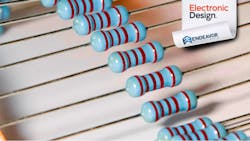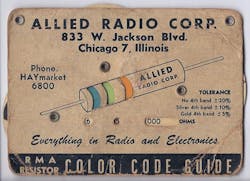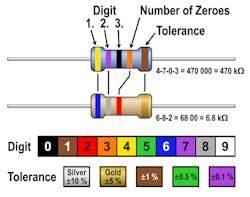Resistor Two Day is Today
This article appeared in Electronic Design and has been published here with permission.
Color coding is a common way to provide easy identification of characteristics like the resistance value of a resistor. Electronic Design is celebrating its 70th anniversary this year, but the encoding scheme employed with resistors predates this starting back in the 1920s. The Radio Manufacturers Association (RMA) came up with its standard (Fig. 1).
Today is the 2nd of February in the year 2022, and red is the color used to encode two. Unfortunately, today’s five-band scheme uses a different color for the five band that indicates the tolerance of the resistor. Of course, we can cheat and apply red instead of silver or gold to get a red five-band resistor. This would have a rating of 22,200 Ω. If the last red band was a golden red, then the tolerance is ±5% (Fig. 2).
The numeric encoding for the first three or four bands is:
- 0 – black
- 1 – brown
- 2 – red
- 3 – orange
- 4 – yellow
- 5 – green
- 6 – blue
- 7 – violet
- 8 – grey
- 9 – white
Innumerable mnemonics have been used to help recall this sequence. Some can’t be repeated, but here are a few I found on Wikipedia:
- Bad Beer Rots Out Your Guts But Vodka Goes Well – Get Some Now
- Betty Brown Runs Over Your Garden But Violet Gingerly Walks
- Bad Bears Raid Our Yummy Grub But Veto Grey Waffles
Capacitors also can use this color-coded approach. There may be additional bands to specify a voltage rating class as well as temperature characteristics.
These days, tiny surface-mount devices cover most of a printed circuit board. Colorful devices and even through-hole, wire resistors and capacitors are still utilized. Printing is a bit better on tiny devices and text is often used these days instead of color coding, but color still crops up even now.
Nevertheless, it’s a red day for resistors and capacitors. Enjoy.
About the Author
William G. Wong
Senior Content Director
I am Editor of Electronic Design focusing on embedded, software, and systems. As Senior Content Director, I also manage Microwaves & RF and I work with a great team of editors to provide engineers, programmers, developers and technical managers with interesting and useful articles and videos on a regular basis. Check out our free newsletters to see the latest content.>
You can send press releases for new products for possible coverage on the website. I am also interested in receiving contributed articles for publishing on our website. Use our template and send to me along with a signed release form.
Check out my blog, AltEmbedded on Electronic Design, as well as his latest articles on this site that are listed below.
You can my social media via these links:
- AltEmbedded on Electronic Design
- Bill Wong on Facebook
- @AltEmbedded on Twitter
- Bill Wong on LinkedIn
I earned a Bachelor of Electrical Engineering at the Georgia Institute of Technology and a Masters in Computer Science from Rutgers University. I still do a bit of programming using everything from C and C++ to Rust and Ada/SPARK. I do a bit of PHP programming for Drupal websites. I have posted a few Drupal modules.
I still get a hand on software and electronic hardware. Some of this can be found on our Kit Close-Up video series. You can also see me on many of our TechXchange Talk videos. I am interested in a range of projects from robotics to artificial intelligence.



